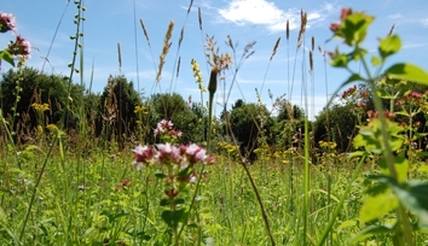Chalk Grassland
|
Chalk grassland is an important habitat at The Sustainability Centre, and one that is under threat nationally. Plants species such as marjoram, carline thistle, agrimony, weld, pyramidal orchid and greater knapweed all thrive here.
Chalk grassland has been created over time through a combination of factors including grazing sheep. A large number of plants have adapted to the sheep's eating habits, the shallow, chalky soil and low nutrient levels. Chalk grassland can contain as many as 40 plant species in every square metre. It has much more biodiversity than the other types of grassland in this country. Some 35 of Britain's 56 butterfly species can be found on chalk grassland, and its protection is a high priority. We also have mounds that have built up on the chalk grassland. These are huge anthills, built up over many generations. They are very important to some of the rare plants; the ants bring chalk to the surface and produce a light airy soil not found elsewhere. The anthills even create their own mini-climate around them, which attracts butterflies such as the Common Blue and Chalkhill Blue. Green Woodpeckers feed here too. If chalk grasslands are ploughed up, overgrazed or allowed to revert to coarse grassland and scrub, many beautiful plants and butterflies will become extinct. Here at The Sustainability Centre we are reclaiming and restoring overgrown areas of chalk grassland, thus providing a haven for plants and insects. |
Hidden GemsThere was word of a hidden parcel of beautiful chalk grassland behind the former garages, near Wetherdown Lodge.
The Volunteer Co-ordinator Rachael Mariey set to work with a small group of volunteers to uncover this beauty for all to enjoy. Sycamores were decked to reveal steps, rubble removal is ongoing, yews are in the process of being pruned, and suddenly...a gorgeous mini meadow is unveiled! Over 30 flowering species have been observed, including field scabious, ox-eye daisy, bird's foot trefoil, vetch, knapweed, wild carrot and lady's bedstraw, hedge woundwort and hemp agrimony. Scores of insects are enjoying this rich resource, with butterflies, including the beautiful marbled white, peacock and silver-studded blue, fluttering by and cinnabar moths and bees zooming around. A path has been strimmed to enable access whilst protecting the meadow from trampling. This area is a valuable seed source, especially since it harbours some flowers which are not present throughout the rest of the site. So part of this ongoing project will include seed collection for distribution in other parts of the site. |



